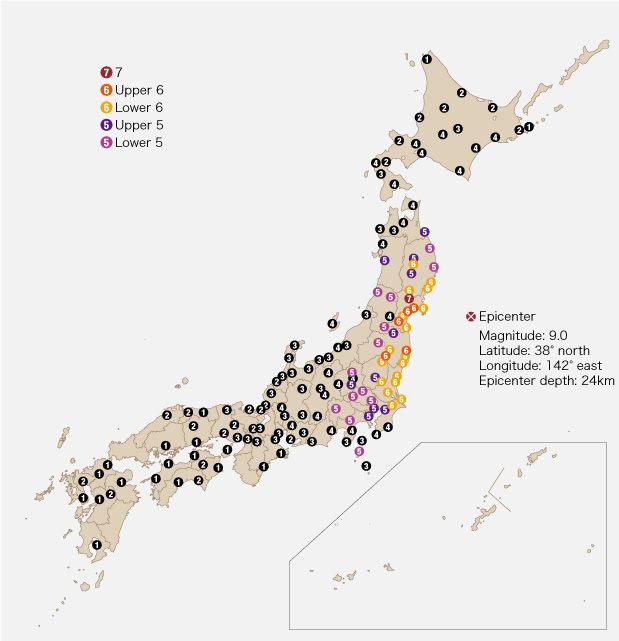Overview of the Great East Japan Earthquake
Society Disaster Opinion 3/11- English
- 日本語
- 简体字
- 繁體字
- Français
- Español
- العربية
- Русский
Overview
The Great East Japan Earthquake that devastated the Tōhoku region struck on Friday, March 11, 2011 at 2:46:18 p.m. The epicenter was off the coast of the Sanriku region in northeast Japan (around 130km east southeast of the Oshika Peninsula), at a depth of approximately 24km. The magnitude 9.0 earthquake was the strongest ever recorded in Japan, and the fourth largest anywhere in the world since 1900 according to the United States Geological Survey.
Strong tremors were felt across a wide area. On the Japanese seismic intensity scale, which measures the perceived intensity of tremors in different locations in units called Shindo, the earthquake measured a level of Shindo 7 in Kurihara, Miyagi Prefecture; Upper 6 in other parts of Miyagi Prefecture and in Fukushima, Ibaraki, and Tochigi Prefectures. Tremors measuring Shindo Upper 5 were recorded as far away as Tokyo.
●Official name: 2011 Tōhoku Region Pacific Coast Earthquake
●Date: March 11, 2011 at 2:46:18
●Epicenter: Off the Sanriku coast, northeast Japan
Latitude: 38° 6’ 12” north
Longitude: 142° 51’36” east
●Epicenter depth: Approx. 24km (provisional figure)
●Magnitude: 9.0
●Max. seismic intensity: 7 (Kurihara, Miyagi Prefecture)
Source: Japan Meteorological Agency
Seismic Intensity in Areas of Japan
| Seismic intensity (Shindo) | Human perception and reaction | Indoor situation | Outdoor situation |
|---|---|---|---|
| 0 | Imperceptible to people, but recorded by seismometers. | - | - |
| 1 | Felt slightly by some people sitting still indoors. | - | - |
| 2 | Felt by many people sitting still indoors. Some people may be awoken. | Hanging objects such as lamps swing slightly. | - |
| 3 | Felt by most people in buildings. Felt by some people walking. Many people are awoken. | Dishes in cupboards may rattle. | Electricity wires swing slightly. |
| 4 | Most people are startled. Felt by most people walking. Most people are awoken. | Hanging objects such as lamps swing significantly, and dishes in cupboards rattle. Unstable ornaments may fall. | Electricity wires swing significantly. People driving cars may notice the tremor. |
| Lower 5 | Many people are frightened and feel the need to hold onto something stable. | Hanging objects such as lamps swing violently. Dishes in cupboards and items on bookshelves may fall. Many unstable ornaments fall. Unsecured furniture may move, and unstable furniture may topple over. | In some cases, windows may break and fall. People notice electricity poles swinging. Roads may suffer damage. |
| Upper 5 | Many people find it hard to move; walking is difficult without holding onto something stable. | Dishes in cupboards and items on bookshelves are likely to fall. TVs may fall from their stands, and unsecured furniture may topple over. | Windows may break and fall, unreinforced concrete-block walls may collapse, poorly installed vending machines may topple over, drivers may be forced to pull over. |
| Lower 6 | It is difficult to remain standing. | Many unsecured furniture moves and may topple over. Doors may become wedged shut. | Wall tiles and windows may be damaged and fall. |
| Upper 6 | It is impossible to remain standing or move without crawling. People may be thrown through the air. | Most unsecured furniture moves, and is more likely to topple over. | Wall tiles and windows are more likely to break and fall. Most unreinforced concrete-block walls collapse. |
| 7 | Most unsecured furniture moves and topples over, or may even be thrown through the air. | Wall tiles and windows are even more likely to break and fall. Reinforced concrete-block walls may collapse |
Source: Japan Meteorological Agency
